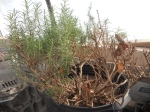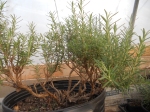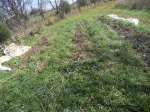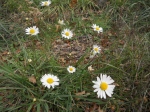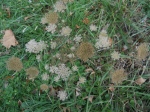You are currently browsing the category archive for the ‘Garden Progress’ category.
Readers, just make allowance: Fall garden-keeping is undramatic, and on the drab side, image-wise. On the other hand, it is restful: sometimes the plants seem as ready for dormancy as we are.
On the other hand, there is always beauty for those who look. Thank you for seeing!
- Grateful for the light: looks like a work day!
- Greenhouse sadly neglected, including this drought-damaged Rosemary
- But it takes so little to restore healthy life!
- Hateful job, clearing tomato vines, untangling ties & trellises, row by row…
- … the reward: somehow this Monarch chrysalis avoided being trampled during a long tomato season
- One of my best Squash seasons ever, ends honorably for the stout, productive vines.
- Daisies in November… strange but still lovely…
- ….and not a yard away, Queen Anne’s own pattern of fading loveliness
Thought you might enjoy an image of damp ground, after so many dry days. In many ways a very frustrating early season…
– incessant rain April-May, delayed tilling
– merciless heat June, scorched snap peas
– “exponential” squash bugs, devastated squash
– July drought, halted clover (nectar)
– compacted ground, reduced garlic crop
– late setting of tomato and chile plants
– etc etc, oh you know
…has become a promising late one.
– cool nights
– more rain than a lot of folks have gotten
– Fall seeds sown, soaked and growing
– rebirth of clover, lespedeza and Goldenrod nectar flow
- Quarter-inch rain, just in time for rapini, bok choy, escarole & endive sown last week
- Sweet 100 cherry t’s deserve both names
- Kung Pao (cayenne) – first of dozens, the perfect “green chile”
- Poblanos, most used in Mexico for chiles rellenos
- Anaheim/Hatch/New Mexico chiles, my own favorite
- A sign of good soil: when the San Marzanos’ foliage is so green it’s blue
- “Just” another honeybee? Most important worker of all!
Last point from these images: thorough pollination and fruit set for tomatoes, tomatillos and chiles, for which the credit goes to Shady Grove’s new hundred thousands of winged workers.
…for us and the bees.
I spend the entire Summer explaining “pruning,” instead of pinching, Basil. “Pruning” means cutting off the whole stem, so the plant keeps branching – not pulling off single leaves here and there, which robs the plant of nutrition without stimulating new growth. When the side shoots are this size, prune them the same way. See below. You’re welcome. A public service.
Next, progress, more progress, fun and fellowship.
- See the third set of leaves above the soil ? That’s where to prune.
- My niece and great niece sharing some enjoyment and labor
- Cherry tomatoes, all trellised
- The sauce tomatoes have a good start
- The blessing of rain allowed for a good thorough hoeing
- Finally all sprouted and growing
- Already, iIn the tiniest pod, the beans are visibly forming
- Buckwheat is flourishing and bees have found it
- … and are harvesting
- Young workers are drawing comb on three frames of their new medium
- The hive mother, on the last of the deep frames to be filled with brood
No, not at all. A dollar’s worth of Garlic, ten dollars worth of information.
It happens every year when freshly harvested Garlic reaches Market. I should charge for advice, or say, “I’ll tell you if you buy some Garlic.”
So, here you are: Garlic FAQ!
“When do you plant yours?” October-November. “October? Really?” “Yes, really.” It will send up a small leaf or two. Mulch it with dry leaves, and the roots will develop underground all through cold weather. When the soil begins to warm (February or March), gently rake the mulch aside and cultivate between the bulbs.
What’s a Scape? You’ll see these at Market in May or June: they’re the “flower stalk” of some Garlic varieties. But instead of seed, they make small “bulbils” which can be replanted to (eventually) grow into bulbs. Usually we just snap off the scapes when they’re still tender, to use as a vegetable. This also leaves more nutrition for the bulbs.
How do you tell when it’s ready to dig? One way to keep track is to plant small irregular cloves thickly in their own row, and harvest them at scallion size for delicious Green Garlic. You will notice them begin to bulb around late April, so you can tell that the bulbs on the good thick stalks are developing too.
Should you wait till the leaves are all brown? Absolutely not. Each long flat leaf extends down to make a layer of wrapper around the bulb. Every one that withers is a layer of protection lost. When the bulbs are a good size, dig the garlic, no matter how green the leaves still are.
Should I cut the tops off or leave them on? Ever buy supermarket garlic and had it shrivel up inside the skin in a week or two? That’s because large-scale growers do cut the tops off to dry the garlic quickly and keep it in storage, and may use heat to dry it. They don’t care: it’s a commodity.* You leave the tops on, so the garlic will cure properly (see next FAQ). Yours is food.
How long should I let it dry? Ack! Bulb garlic doesn’t “dry,” it cures! That means that the moisture and nutrients in those green leaves are absorbed and sealed into the cloves. This keeps them plump and solid even in storage. I used last June’s garlic harvest well into this Spring.
Sorry, ain’t no short answers. Leave the tops on till they are completely dry and brittle and can be twisted off by hand. With hardneck varieties, you may have to cut the stalk.
What do you do with it? Geez, lady, what do you do without it? (The young lady had sniffed disdainfully and said she only liked Garlic Powder) See Recipes, next post.
* Difference between a “crop” and a “commodity:” a crop is meant principally to be grown, and eaten. A commodity is meant principally to be bought and sold. My investment broker friend Mark tells me the problem with commodities is that “the producer doesn’t get quality signals from the consumer.” So if something you like (apples, houses, health care, information) becomes a commodity, watch out!!
Just going thru some unusual plant images, both from this Winter and last year. One thing these have in common: all are edible.
A little-known aspect to edible wild plants, but not surprising: most are kin to our cultivated species. An even lesser-known aspect, to the point where you probably won’t read it anywhere but here: altho goats have the name of eating everything, a herd that has access to diverse vegetation (NB that’s a kind way of saying “neglected pastures) are notably choosy. To the point of butting their herd sisters away from some of the choice species. And most of these, such as the wild mustards, are kin to human food plants!
How to explain the symmetry between their preferences and ours: goats are the earliest domesticated grazing animal, and come from the same region (Central Asia) as the great majority of our crop species. So we share a botanical heritage with them.
Corollary: you think this explains the compatibility of both goat meat and goat milk to human digestion? Hmmm.
- Lambsquarters, fine edible, kin to beets and amaranths
- Black Mustards, indifferent to frost
- A new cross: Osaka Purple with Black Mustard. Saving seed.
- Tick-trefoil, inspiration for Velcro: perennial legume, ancestor of soybean.
- Field thistle: white underleaves: vegetal coagulant for cheese-making
- Horse nettle clearly shows its kinship with Eggplant
Does someone have a book out by that name? Too bad. Most garden books, if you sort out the actual new content (season extension, herbs, raised beds etc) could be condensed into an article about as long as one of these posts.
A few rules, based on my 50+ years’ garden experience
Rule # 1. Get out of the wet socks. Doesn’t matter if you have 18 things to do, and can’t decide which should be first. Once you have dry socks on, everything else will be more fun.
Rule #2. For the first half hour before doing anything fun, pick up trash, sort and stack stuff. You make your work easier, plus whatever you do next will definitely be more enjoyable. Remind yourself, “This is for me. It’s not for my second-grade teacher.”
Rule #3. Pick something fun. ( I picked shifting compost) If it’s not the highest priority, while you’re doing it you’ll think of whatever is. Yesterday, that turned out to be pulling the weed stalks from the former Garlic rows. As it happened, I needed them to refill the Accumulation section of the Central Compost Facility after I shifted the Working pile to the Sifting section, and the old Accumulation to the Working section.
Rule #4. You want four rules?When my friend Newton supervised the loading area of a local bakery, he enacted two: “If something is falling on you, get out of the way,” and “Give Harold [the biggest, surliest route salesman] whatever he wants.” 3 rules are enough for anybody.
- My neighbor Mike was working on this while I had fun with compost
- This hadn’t been touched since the Spring.
- Needs weeding before anything else!
- After “working” all summer, it goes to the sifting section
- Cleared and ready to shift the Accumulation pile
- And it’s shifted!
- … a forest of Wild carrot, Ragweed and Teazle…
- …become the new Accumulation pile
- Something to admire, going to and from the barn
- Mike’s work, a noticeable difference: 100 feet cleared along my new land across the road.
For almost 16 years, showing visitors the big garden across the road, I have felt compelled to explain that the land wasn’t mine: it belonged to the farm that adjoins mine on the South. It was an orphan plot left when US 25 and the Southern Railway cut off a number of loops of the old Covington-Lexington Pike: that family bought it in. My neighbors, a kind older couple, had let me use it (it’s flatter than anything near my house) since the mid 90’s, but declined frequent offers to buy it.
Now both are gone, and their farm is up for sale. This week brought the conclusion of a deal to add the 2.6 acres to Shady Grove Farm.
For all those years of adding mulch and manure, trying tiller after tiller till finding the best one to work the clay soil, digging up inconvenient rocks, I thought only vaguely about what I could do if it were mine.
Crunch time! How’s this for a list?
Clear fence row: tricky, as the scrubby trees conceal fragments of tough old wire, but may also support promising bittersweet vines
Raised beds: a massive task, not one I’d tackle on land I didn’t own, and which still can only be done one plot at a time
Cut brush back to right-of-way fence
Drop big trees that now shade the far west ends of planted rows
Post signs (I’m gonna love this part) saying “Property of Shady Grove Farm: please no trash!”
Wait for the locust trees that I had to bushhog around, to get a little stouter, then cut them for fence posts
Now all that work of mowing, soil improvement, rock removal, drainage, brush clearing, has come home to benefit my own farm. What next?
- … fills both tanks which gravity-feed into the stock troughs downhill. A little forethought and gutter work conserves water, time and effort.
- … tilled soil becomes soft level rows for Fall greens
- .. to get the spud bar (& camera!) to remove a huge slab of rock uncovered in tilling
- … 8′ of locust,,32″ in the ground, anchoring a stout pen for Nobel and the does
- … Bok Choy seedlings appear, amid crumbled clay, friable after a ten-year investment of manure, mulch and compost. Oh, and sweat!
- … the rainbow and the bundle of new T-posts foretell a productive week
- … radishes, sown too early, germinated poorly in the heat, while the pigweed & nutsedge flourished
- … new life – a grape tendril in misty late sunlight
Anybody else think the Masters of the Universe appeared a little flummoxed* this week? You know, those guys in loosened ties and flapping white collars, who rule the world these days? Whose every wince and quiver is taken as augury? Hey, stay with me – Wall Street!
Buy! Sell! No, buy! Greek debt – sell! Debt deal – buy! Debate produces no clear winners – sell! Crop failure – buy! Profit taking! Sell! Eurostates ban short sales – buy! London riots – Uh – Buy? Sell?Prompting the heartfelt question – Do any of those people know WTF they are doing?
Here’s an insight: why they call mine a “Simple Life.”
Sunday: haul water RAIN! Fill stock tanks troughs
Monday: M-7, rake & sow Fall greens move rock
Tuesday: bushhog – buck’s pen
Wednesday : mulch Marzanos: sow Fall greens
Thursday: weed and re-sow radishes
Friday: Market prep
This list simplified from the real envelope, shows decisions in high relief. July’s searing heat was rough on garden, pastures and stock. Without Sunday’s blessed rain (and more, Tuesday, Wednesday and Saturday) I would have hauled, at a minimum, 3 tank loads from the country water tap, a 6-mile drive and $3 apiece in quarters. And got nothing else done, that day.
Plot 7 of the Main garden was tilled a few weeks back. Two days of raking to re-contour: as each row was smoothed, another crop of seed went in: Bok Choy, Tatsoi, Tronchuda, Broccoli Raab, Escarole, Endive, Radicchio, Mustards, Collards, Arugula.
The tendency of cool-weather vegetables to bolt (set seed) often frustrates us in getting a leafy crop to harvest. 50 years of gardening (the last 16 for Market), and coaxing 2 or 3 seasons of crops from the same soil, led to an observation: not so much heat or sunshine, but daylength, triggers this change in the plant’s chemistry. (Of course it’s chemical. Just taste a leaf of any of the above, first at the basal rosette stage and then after bolting.)
So, rain favoring, once the year has turned (early August, as the days barely decrease from June 21 till then) any number of Fall seeds can be sown, to sprout and get their growth before the bitter cold.
Tuesday I laid out to get on the tractor and get mowing the big hayfield. With my right arm Steve unavailable (thru a richly-deserved surge of photographic work – see pasztphoto link in Blogroll) my aim shifted to setting the other corner post for Nobel’s pen, then unclipping the sloppily strung fence from last year, to move the crooked-set T-posts and reclip a new, straight line. Breeding season is soon upon us, and there will be a stout pen with plenty of browse for Nobel and each doe as she cycles.
A phrase I like: “Pick your poverty: no time, no money, no soul.” Think it thru. If you have both time and money, it’s at the expense of your soul (example, drug dealers.) If you make money, and hang onto your soul, you lack time to live the kind of life money would allow (example. a conscientious physician or surgeon). Or you can have time and your soul, but no money (me). Of course, a lot of that time is going to be spent doing what the first category might consider work. Years ago a customer opined that I wasn’t charging enough for fresh shelled beans. I said “How much do you make for sitting on a shady porch on a hot day?”
I can’t control weather. I can suggest but not dictate customer tastes, as the “crackhead economy” does thru television. Given soil and rain, I can plant, weed, gather and sell. Given animal health & fertility, I can breed, deliver, process and sell. Given a large rock, I move it. On a given day, I know what to do.
So I’m keeping my investment where it is.
*Flummoxed – perplexed, dumbfounded: from OE “flume ox,” the animal harnessed to a turnstile which lifts the gates of a water mill. If left untended, it would speed or slacken its pace by what it heard of the water in the millrace. The phrase came to mean beset by conflicting information in a manner that forestalled rational choice.
Mentioned to a customer that I was ‘revelling’ in Garlic: the largest bulbs are saved out for seed, and the good-sized ones for Market, leaving a whole bread tray of “using Garlic,” not pretty enough to sell. She chided me a bit: “We don’t expect perfect vegetables! That’s a supermarket tactic!”

Left, Bogatyr; center, Chrysalis Purple; top, California White; upper right, Spanish Roja; lower right, German White: I think this year's is my best ever Garlic crop. Or maybe just the prettiest!
No, I don’t imagine you require perfection, along with freshness, flavor, sustainability and freedom from chemicals. But produce should be pretty. There is great beauty in growing things, and our work is lightened by admiring it. It’s only fair to share that, along with the other fruits of our labor.
Cf. pasztphoto.smugmug.com/Growing
Four or five gardeners, at Market yesterday, had the same comment: all male blossoms on their Zucchini: no little squash! I noticed years ago that male blossoms always appear first, and lots of them, before the first female blossom with a tiny fruit at the base. Thinking it through, it seems producing pollen is a quick and “inexpensive” survival strategy for the plant’s genes. Producing a fruit and ripening it to viable seed stage takes a lot more energy and carries more risk. Patience: those tiny beauties will be along!
To help you revel in your own Garlic, or a farmer’s….
Home made ranch dressing: 1 cup each, mayonnaise & buttermilk: 1/4 cup aged Feta; 2 tbps (about 6 good cloves) minced fresh Garlic; bunch minced Flatleaf Parsley; plenty coarsely ground black pepper. Combine in a quart jar, cover with tight lid and shake. Let stand a few hours. Shake again before using.

The best butternut squash always seem to sprout in the compost pile. This is the prettiest one of a couple dozen, but it was hard to decide.
- Too wet to till? There’s always the spading fork and hoe!
- Hitting their stride – 3 lb in a day
- Okay in plugs for now – good thing too!
- Now 5 varieties, with Korean Vining Squash seeds from Moon
- Best garlic crop of all – with nods to Colleen and Steve
- Beautiful soil, in my oldest worked ground


